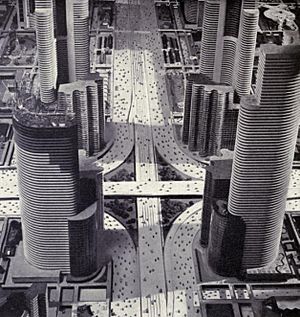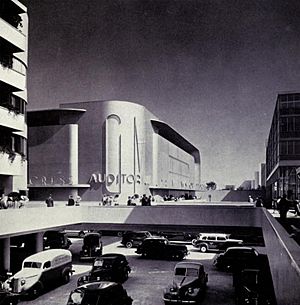Futurama (New York World's Fair) facts for kids
Futurama was a famous exhibit and ride at the 1939 New York World's Fair. It was created by a designer named Norman Bel Geddes. This exhibit showed people what the world might look like 20 years later, around 1959 or 1960. The car company General Motors paid for Futurama. It featured amazing automated highways and huge suburban areas.
Building the Future Vision
Before Futurama, Norman Bel Geddes built a smaller model city in 1937. This model was for a Shell Oil advertisement and was called the "Shell Oil City of Tomorrow." It was like a practice run for the much bigger and more detailed Futurama exhibit.
A Glimpse into Tomorrow
Geddes' vision for the future was quite realistic. One of the most advanced ideas was an automated highway system. General Motors even built a working version of this by 1960! Many people believe Futurama was the first time most Americans learned about a national network of expressways. These are like modern-day freeways.
The exhibit connected the popular streamlined style of the 1920s and 30s with new ideas for street and highway design. Geddes explained his ideas in his book, Magic Motorways:
Futurama is a large-scale model representing almost every type of terrain in America and illustrating how a motorway system may be laid down over the entire country—across mountains, over rivers and lakes, through cities and past towns—never deviating from a direct course and always adhering to the four basic principles of highway design: safety, comfort, speed, and economy.
The model highways offered hope for the future. They showed a possible solution to the traffic congestion problems of the time. They also predicted how much traffic would grow as more cars were used over the next 20 years. Bel Geddes thought cars would still be the main way people traveled in 1960. He imagined more cars and faster traffic lanes.
Futurama showed four main ideas to improve roads:
- Each road section could handle more traffic.
- Traffic moving in one direction was kept separate from other traffic.
- Cities were divided into units to control traffic, letting people walk more easily.
- Traffic rules included maximum and minimum speeds.
The exhibit aimed to get people excited about better street and highway planning.
The Futurama exhibit was very popular. It fit perfectly with the fair's theme, "The World of Tomorrow." It focused on the future and how the American landscape could be redesigned. The highway system was part of a 1-acre animated model of a future America. This model had over 500,000 tiny buildings and a million trees of 13 different types. It also featured about 50,000 cars, with 10,000 of them moving along a 14-lane highway!
Futurama showed an American utopia, a perfect place controlled by new technologies. This included multi-lane highways with remote-controlled semi-automated vehicles. There were also power plants, farms for artificially produced crops, and even rooftop landing pads for flying machines. All these things were meant to create an ideal environment and improve society.
Geddes' vision of the future was all about new technology. Visitors experienced this through a simulated low-flying airplane journey. This "flight" was an 18-minute ride on a conveyor system. It carried 552 seated people at a time. The ride moved along a winding path, about ⅓ of a mile long, with special lights, sounds, and colors. It moved at about 120 feet per minute, or 1.36 miles per hour. This allowed people to look down through a curved glass window at the detailed model. From this high view, visitors could see how city blocks fit with the highway system. They could also see tiny, controlled trees inside glass domes. The model was built using 408 sections based on aerial photos of different U.S. regions, provided by Fairchild Aircraft Ltd..
Futurama's Lasting Impact
The General Motors pavilion at the 1964 New York World's Fair also had a ride called "Futurama," or "The New Futurama." This showed that the ideas from the original exhibit continued to inspire people.
See also
 In Spanish: Futurama (exhibición) para niños
In Spanish: Futurama (exhibición) para niños






